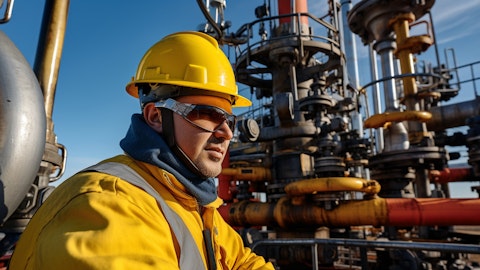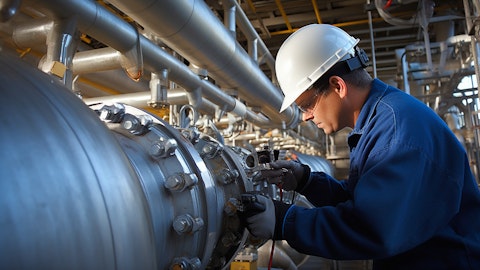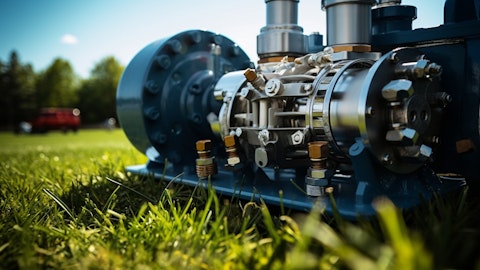James Rollyson: Absolutely, Doug. It wasn’t a slide against you? It was more just a relative where capital is going between dividend…
Douglas Aron: I didn’t take it that way. Just a short advertiser, but Jim, thanks.
James Rollyson: Sure. Well, it’s a high-class problem to have to choose which path to take of many. So congrats again, guys. Thanks.
BradleyChilders: Thank you, Jim.
Operator: Our next question comes from Selman Akyol from Stifel. Your line is now open.
Selman Akyol: Thank you. Good morning. So, you talked about the gas lift market, and I was wondering if you could expand a little bit on that. What kind of opportunities do you see there? Maybe talk a little bit about the customer demand you’re seeing there? And then does that also have similar economics relative to what you think of coming off the backside of the plants in transportation?
BradleyChilders: Thanks, Selman. I’ll talk about the market opportunity first. Number one, what we see for gas lift, it’s grown proportionately with what we’ve seen for gathering stated differently, the percentage and mix of what we have for compression on gas lift on a horsepower basis has basically been a consistent percentage compared to the entire fleet in application to gathering and gas lift. It’s moved around a little bit, but been very consistent. So – and as you know, gas lift is really directed for oil production. It’s used to – like an ESP or other technology to help relieve the pressure in the wellbore itself to facilitate production. So gas lift very directly tied to oil production as opposed to just pure gas production and gas gathering.
And that means that it’s a good market because we see forecast for oil growth going forward, and especially in the Permian. So it’s a super strong market. We’re going to, I think, continue to see good growth there, and we’re going to benefit from it. As far as the back part of your question related to what we see on the recompression post plant. No, they’re totally different applications to be direct. That’s much more of a transportation and gathering applications, than…
Selman Akyol: Yes, I misspoke on that. I guess what I’m just curious if you think about just the gathering side of it versus the gas lift, is it the same contract tenor or is it the same pricing? Are you seeing all the same dynamics in one versus the other?
BradleyChilders: Yes. The dynamics are very comparable. The economics are identical. Compression equipment is the same in both applications.
Selman Akyol: Understood. And then you undertook an optimization effort, I guess, through data gathering. Can you talk about how is that going and where you see that?
BradleyChilders: Yes. It’s pretty exciting stuff, to be honest because over the last three years, we’ve added telemetry to every unit in the field with multiple points of data coming in off of the edge devices. It’s being collected through a data engine that we are just starting to really figure out how to utilize very well to improve and drive great customer service, economics and efficiency in the field and the technicians and service managers that are really on the front end of utilizing that. What’s great about the information that’s coming in is that on a preventative and predictive maintenance perspective, we can look at what’s going on with the units remotely and start to diagnose and address issues before they turn into downtime.
That’s super exciting. We can do a lot of that work over the air through adjustments with increasing efforts to automate aspects of what we’re operating in the field today. So all of that, we believe, is going to continue to allow us to offer a differentiated level of customer service, and a much higher level of efficiency. We expect to have to roll the Archrock and go touch the units less than in the past when we did not have this technology available for us. So it’s a pretty exciting time. That’s the way that optimization is working.
Selman Akyol: Any ideas when we should start expecting to see that show up in margins?
BradleyChilders: You’re seeing some of that show up in margins already. And by the way, the beauty of that is the customers are also experiencing that at a customer service level. So when you think about the amount of profitability that we should be allowed in this business given the investments we’ve made, the improvements in service that we’re delivering, we’re pretty ambitious that we should be able to turn that into margin on a go-forward basis as well.
Selman Akyol: Understood. And then last one, just in terms of following up to the last question and some of your answers there. You talked, I guess, about seeing LNG and talking about sort of robust growth ahead. And I’m just translating that in my mind to sort of CapEx budgets as you think about capital allocation. So I guess you’re positioning us to expect higher expense going forward into ’25 and ’26?
BradleyChilders: Directly, no. We are not positioning the expectation for higher CapEx in 2025. And yet, we are also not providing guidance for 2025. It’s still really going in 2024. It’s going to be a while before we can get there. But what I would say is that we’re excited that the market remains as tight and as robust as we are seeing. We are not adjusting our allocation framework, and we’re not trying to guide an expectation of a different level of investment in the future. We still remain very dedicated to returning cash to investors and to generating free cash flow.
Selman Akyol: Perfect. Thanks so much.
BradleyChilders: Thank you.
Operator: Our next question comes from Josh Jayne from Daniel Energy Partners. Your line is open.
Josh Jayne: Thanks. Good morning. I just wanted to back to something you noted on your last conference call that 30% of equipment is typically at least 70% owned. But in the Permian, that lease percentage is much higher. I was hoping you guys could just expand on why exactly that is and where you expect the Permian to rank from sort of an incremental horsepower standpoint over the next couple of years?
BradleyChilders: Yes. Thank you for the question. First, the data on this is not 100% known. That is we don’t have complete accurate visibility into the amount of horsepower owned and operated by all the customers. So our comments are, we believe, are directional and accurate, but not exactly just because that information is not available. So with that caveat, what I’d share is that the Permian was growing fast over the most recent period of time. At a time when the entire industry, including the producers, and the midstreamers, service providers, compression service providers, we’re all focused on capital discipline and leaning that in that was supportive of candidly more outsourcing for capital reasons, we think, by the producers and by the midstreamers than we had experienced before this most recent capital discipline.




